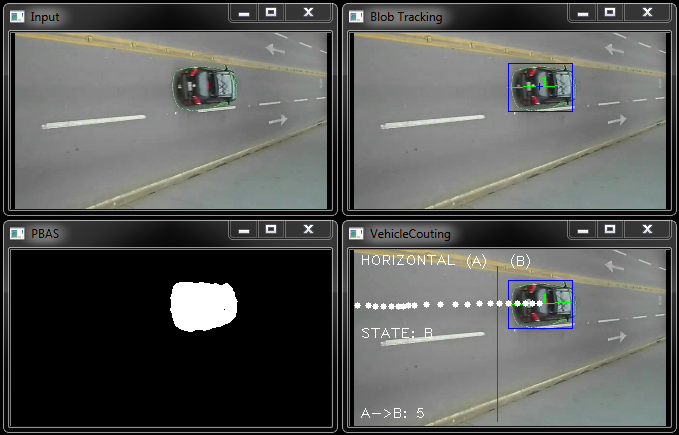https://github.com/andrewssobral/simple_vehicle_counting
Vehicle Detection, Tracking and Counting
https://github.com/andrewssobral/simple_vehicle_counting
background-subtraction opencv vehicle-counting vehicle-detection vehicle-tracking
Last synced: 8 months ago
JSON representation
Vehicle Detection, Tracking and Counting
- Host: GitHub
- URL: https://github.com/andrewssobral/simple_vehicle_counting
- Owner: andrewssobral
- Created: 2015-04-29T22:01:59.000Z (over 10 years ago)
- Default Branch: master
- Last Pushed: 2020-03-07T22:05:56.000Z (over 5 years ago)
- Last Synced: 2025-03-29T03:11:22.444Z (8 months ago)
- Topics: background-subtraction, opencv, vehicle-counting, vehicle-detection, vehicle-tracking
- Language: C++
- Size: 20.8 MB
- Stars: 502
- Watchers: 59
- Forks: 246
- Open Issues: 21
-
Metadata Files:
- Readme: README.md
Awesome Lists containing this project
README
Vehicle Detection, Tracking and Counting
========================================
Last page update: **12/04/2017** (Added Python API & OpenCV 3.x support)
Last version: **1.0.0** (see Release Notes for more info)
Hi everyone,
There are several ways to perform vehicle detection, tracking and counting.
Here is a step-by-step of a simplest way to do this:
1. First, you will need to detect the moving objects. An easy way to do vehicle detection is by using a Background Subtraction (BS) algorithm. You can try to use a background subtraction library like [BGSLibrary](https://github.com/andrewssobral/bgslibrary#bgslibrary).
2. For vehicle tracking, you will need to use a tracking algorithm. A simplest way to do this is by using a blob tracker algorithm (see [cvBlob](https://code.google.com/p/cvblob/) or [OpenCVBlobsLib](http://opencvblobslib.github.io/opencvblobslib/)). So, send the foreground mask to **cvBlob** or **OpenCVBlobsLib**. For example, the **cvBlob** library provide some methods to get the **centroid**, the **track** and the **ID** of the moving objects. You can also set to draw a **bounding box**, the **centroid** and the **angle** of the tracked object.
3. And then, check if the **centroid** of the moving object has crossed a **region of interest** (i.e. virtual line) in your video.
4. Voilà! enjoy it :)

Citation
--------
If you use this code for your publications, please cite it as:
```
@ONLINE{vdtc,
author = "Andrews Sobral",
title = "Vehicle Detection, Tracking and Counting",
year = "2014",
url = "https://github.com/andrewssobral/simple_vehicle_counting"
}
```
For Windows users
-----------------
* There is no Visual Studio 2013 template project anymore. Please, use CMAKE instead.
#### Compiling with OpenCV 3.x and Visual Studio 2015 from CMAKE
**Dependencies:**
* OpenCV 3.x (tested with OpenCV 3.2.0)
* GIT (tested with git version 2.7.2.windows.1).
* CMAKE for Windows (tested with cmake version 3.1.1).
* Microsoft Visual Studio (tested with VS2015).
*Note: the procedure is similar for OpenCV 2.4.x and Visual Studio 2013.*
Please follow the instructions below:
1) Go to Windows console.
2) Clone git repository:
```
git clone --recursive https://github.com/andrewssobral/simple_vehicle_counting.git
```
3) Go to **simple_vehicle_counting/build** folder.
4) Set your OpenCV PATH:
```
set OpenCV_DIR=C:\OpenCV3.2.0\build
```
5) Launch CMAKE:
```
cmake -DOpenCV_DIR=%OpenCV_DIR% -G "Visual Studio 14 Win64" ..
```
6) Include OpenCV binaries in the system path:
```
set PATH=%PATH%;%OpenCV_DIR%\x64\vc14\bin
```
7) Open the **bgs.sln** file in your Visual Studio and switch to **'RELEASE'** mode
8) Click on **'ALL_BUILD'** project and build!
9) If everything goes well, copy **simple_vehicle_counting.exe** to **simple_vehicle_counting/** and run!
For Linux users
-----------------
* For Linux and Mac users, a CMakefile is provided to compile the source code.
* * Check out the latest project source code and compile it:
```
~/git clone --recursive https://github.com/andrewssobral/simple_vehicle_counting.git
~/cd simple_vehicle_counting
~/simple_vehicle_counting/cd build
~/simple_vehicle_counting/build/ cmake ..
~/simple_vehicle_counting/build/ make
```
* * Run demo:
```
~/simple_vehicle_counting/run_simple_vehicle_counting.sh
```
Docker image
----------------------------------------
* Docker image is available at:
* * **Ubuntu 16.04 + VNC + OpenCV 2.4.13 + Python 2.7 + Vehicle Detection, Tracking and Counting**
https://hub.docker.com/r/andrewssobral/vehicle_detection_tracking_counting/
Example code
------------
```C++
#include
#include
#include "package_bgs/PBAS/PixelBasedAdaptiveSegmenter.h"
#include "package_tracking/BlobTracking.h"
#include "package_analysis/VehicleCouting.h"
int main(int argc, char **argv)
{
/* Open video file */
CvCapture *capture = 0;
capture = cvCaptureFromAVI("dataset/video.avi");
if(!capture){
std::cerr << "Cannot open video!" << std::endl;
return 1;
}
/* Background Subtraction Algorithm */
IBGS *bgs;
bgs = new PixelBasedAdaptiveSegmenter;
/* Blob Tracking Algorithm */
cv::Mat img_blob;
BlobTracking* blobTracking;
blobTracking = new BlobTracking;
/* Vehicle Counting Algorithm */
VehicleCouting* vehicleCouting;
vehicleCouting = new VehicleCouting;
std::cout << "Press 'q' to quit..." << std::endl;
int key = 0;
IplImage *frame;
while(key != 'q')
{
frame = cvQueryFrame(capture);
if(!frame) break;
cv::Mat img_input = cv::cvarrToMat(frame);
cv::imshow("Input", img_input);
// bgs->process(...) internally process and show the foreground mask image
cv::Mat img_mask;
bgs->process(img_input, img_mask);
if(!img_mask.empty())
{
// Perform blob tracking
blobTracking->process(img_input, img_mask, img_blob);
// Perform vehicle counting
vehicleCouting->setInput(img_blob);
vehicleCouting->setTracks(blobTracking->getTracks());
vehicleCouting->process();
}
key = cvWaitKey(1);
}
delete vehicleCouting;
delete blobTracking;
delete bgs;
cvDestroyAllWindows();
cvReleaseCapture(&capture);
return 0;
}
```
Python API
----------------------------------------
A [python demo](python/demo.py) shows how to call the Python API.
It is similar as the [C++ demo](Demo.cpp).
To use the Python API, you should copy ["python" directory](python) to overwrite the generated one.
```
~/simple_vehicle_counting/cd build
~/simple_vehicle_counting/build/cmake ..
~/simple_vehicle_counting/build/make -j 8
~/simple_vehicle_counting/build/cp -r ../python/* python/
~/simple_vehicle_counting/build/../run_python_demo.sh
```
If you have previously built the project at the project root,
make sure there are no previously generated libraries in the ["python" directory](python) by ```make clean```.
Release Notes:
--------------
* 12/04/2017: Added OpenCV 3.x support. Removed vs2013 template project (use CMAKE instead).
* 07/04/2017: Added Python API, thanks to [@kyu-sz](https://github.com/kyu-sz).
* Version 1.0.0: First version.